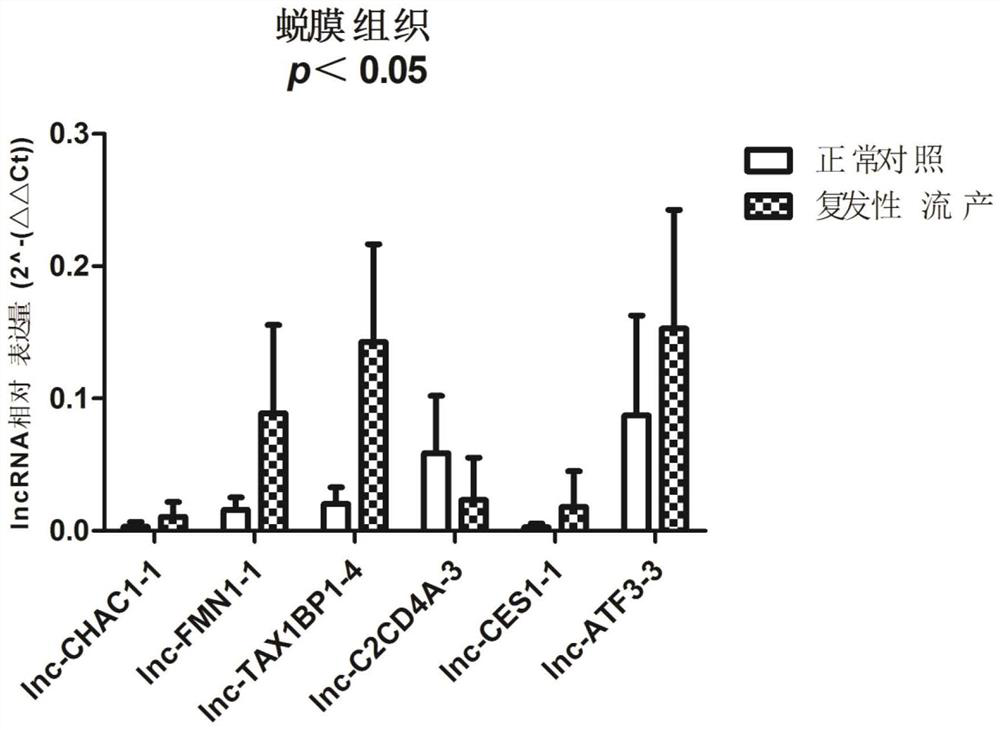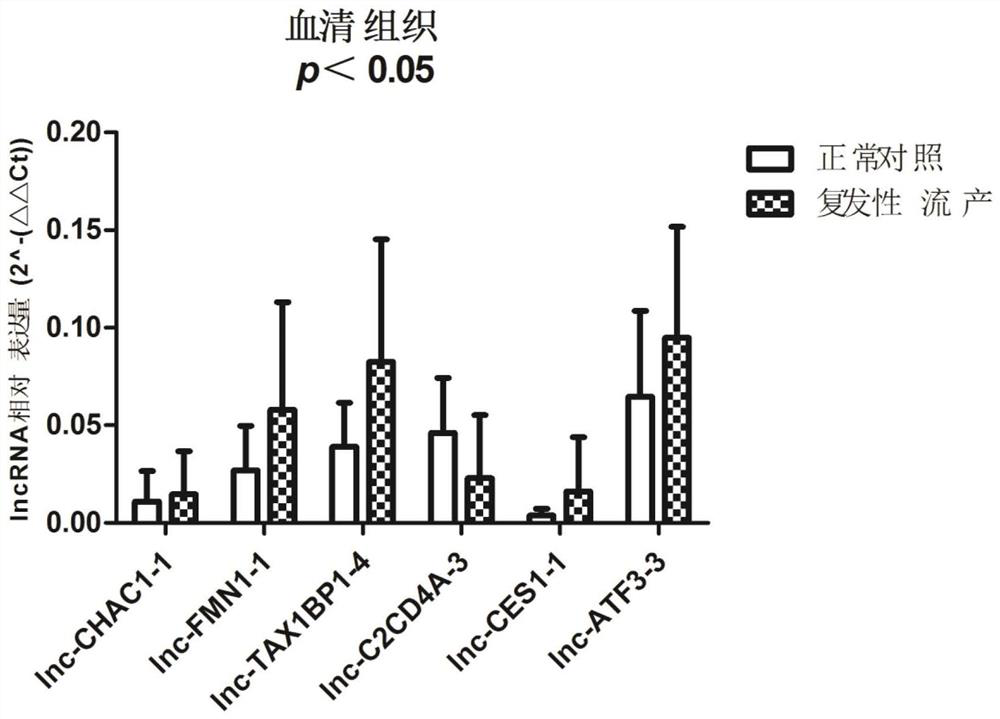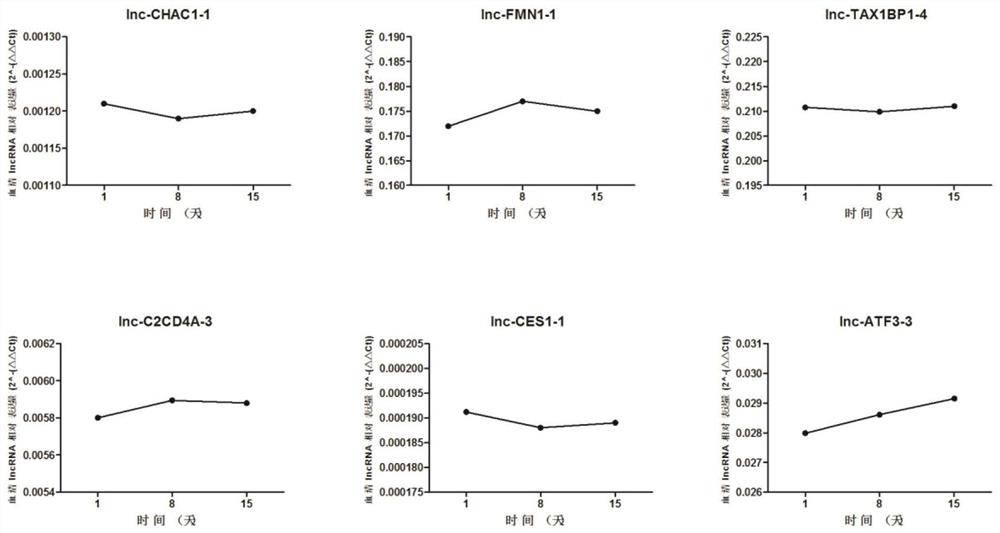Serum lncRNA markers, primer sets, applications and kits for diagnosing unexplained recurrent miscarriage
A technology of recurrent miscarriage and primer set, applied in the field of genetic engineering, to achieve the effect of improving sensitivity and specificity, quantitative accuracy, fast and accurate disease state and disease severity
- Summary
- Abstract
- Description
- Claims
- Application Information
AI Technical Summary
Problems solved by technology
Method used
Image
Examples
Embodiment 1
[0045] Example 1: lncRNA screening of decidua tissue
[0046] 1 material
[0047] 1.1 Selection of research objects and sample collection
[0048] (1) According to the diagnostic criteria: pregnant women with 2 or more consecutive pregnancy losses before 20 weeks of pregnancy or fetal weight less than 500g are the case group; according to age, gestational weeks, BMI and other indicators, the frequency matching method is used to select children Pregnant women with normal ability and non-medical reasons for miscarriage (without signs and signs of miscarriage, no history of miscarriage, and at least one normal child born) were used as the control group.
[0049] (2) B-ultrasound shows no germ or fetal heartbeat, and abortion caused by factors such as monogenic genetic diseases, polygenic genetic diseases, chromosomal abnormalities, and gene mutations must be excluded.
[0050] (3) Grouping of research objects:
[0051] Group A: the control group of pregnant women who chose abo...
Embodiment 2
[0061] Example 2: Detection of the expression levels of lnc-CHAC1-1, lnc-FMN1-1, lnc-TAX1BP1-4, lnc-C2CD4A-3, lnc-CES1-1, lnc-ATF3-3 in decidua tissue
[0062] 1 material
[0063] 1.1 Selection of research objects and sample collection
[0064] The selection of research objects and sample collection in this embodiment are the same as those in Embodiment 1.
[0065] 1.2 Reagents
[0066] The reagents used in qPCR are the same as in Example 1.
[0067] 2 methods
[0068] 2.1 Extraction of total RNA
[0069] The decidual tissues of 63 cases of normal control group and 63 cases of recurrent abortion cases were taken as objects.
[0070] (1) Take 50-100 mg of decidual tissue and grind it in liquid nitrogen, add 1 mL of TRIzol, homogenize it with a homogenate ultrasonic instrument, and place it at room temperature (15-30°C) for 5 minutes to completely separate the nucleoproteinase. (2) Add 200 μl chloroform for every 1 mL of TRIzol used, shake vigorously for 30 s, and place on...
Embodiment 3
[0085] Example 3: Detection of expression levels of lnc-CHAC1-1, lnc-FMN1-1, lnc-TAX1BP1-4, lnc-C2CD4A-3, lnc-CES1-1, lnc-ATF3-3 in serum
[0086] 1 material
[0087] 1.1 Selection of research objects and sample collection
[0088] The selection of research objects and sample collection in this embodiment are the same as those in Embodiment 1.
[0089] 1.2 Reagents
[0090] The reagents used in qPCR are the same as in Example 1.
[0091] 2 methods
[0092] 2.1 Extraction of total RNA
[0093] The serum samples of 63 cases of normal control group and 63 cases of recurrent miscarriage case group were taken as objects.
[0094] (1) Take 5ml of fresh heparin anticoagulant blood and centrifuge at 3000rpm for 5min in a centrifuge, take the supernatant and put it into clean 1.5ml EP tubes, 100μl per tube. (2) Add 900 μl TRIzol to the EP tube, shake and mix well, centrifuge at 12,000 rpm for 15 min at 4°C, and immediately transfer the supernatant to a clean 1.5ml EP tube. (3) A...
PUM
 Login to View More
Login to View More Abstract
Description
Claims
Application Information
 Login to View More
Login to View More - R&D
- Intellectual Property
- Life Sciences
- Materials
- Tech Scout
- Unparalleled Data Quality
- Higher Quality Content
- 60% Fewer Hallucinations
Browse by: Latest US Patents, China's latest patents, Technical Efficacy Thesaurus, Application Domain, Technology Topic, Popular Technical Reports.
© 2025 PatSnap. All rights reserved.Legal|Privacy policy|Modern Slavery Act Transparency Statement|Sitemap|About US| Contact US: help@patsnap.com



